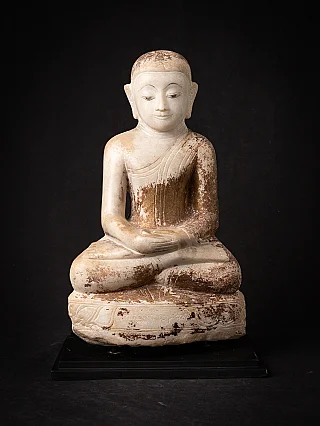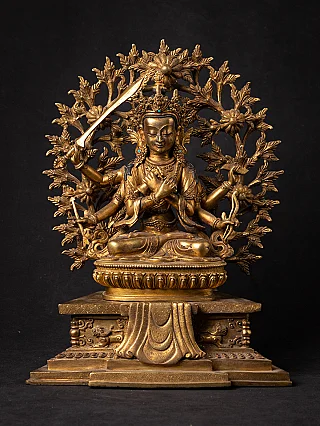Fetters – Chains That Binds To Cycle of Samsara
Author : Peter Vredeveld

Fetters are the mental or intrapsychic phenomenon that binds all sentient beings to cycle of Samsara, life of suffering and pain.
Fetters in Buddhism are defined as the mental chain or bond that binds all sentient beings to the cycle of life of pain and suffering, Samsara. It is believed that fetters bind people and sentient beings from attaining Enlightenment and trap them in the cycle of Samsara. According to Buddha's teachings, one can achieve Enlightenment only by cutting through all the fetters Lord Buddha mentions. According to the history of Buddhism, Lord Buddha, before leaving the royal palace, called Rahula a fetter since the existence of Rahula could bind him to his wife Yasodhara and Rahula too. In the Pali Canon of Buddhism, the word "fetters" describes the mental phenomenon that binds sentient beings to suffering in life and after rebirth.
In particular, in Sutta of Pali Canon, Lord Buddha himself states on the factor of fetters:
"Monks, I don't envision even one other fetter — fettered by which beings conjoined go wandering & transmigrating on for a long, long time — like the fetter of craving. Fettered with the fetter of craving, beings conjoined go wandering & transmigrating on for a long, long time."
The fetters in Buddhism in Buddhism are categorized differently by Sutta Pitaka and Abhidharma Pitaka of Pali Canon.
According to Sutta Pitaka
Sutta Pitaka in Pali Canon enlisted ten different fetters that bind to the cycle of Samsara. They are:

1. Self-Illusion
The first fetter in Sutta Pitaka is self-illusion, which is also known as Sakkaya-ditthi. The view of an unchanging soul or self, as well as the view of no self, is considered wrong in Buddhism.
2. Doubt on the teachings
The second fetter is one's doubt on the teachings of Buddha or about the Dharma. The second fetter is also known as vicikiccha, which means doubt. It is a psychological phenomenon where no answer or no advice could satisfy your doubts about the teachings of Buddha or Dharma.
3. Mere Rule and Ritual attachment
The third fetter is also known as slabbata-parmsa, and the fetter refers to people's attachment to rules, rituals, norms, and values. People thoroughly believe and follow rules, traditions, norms, and values without truly understanding the meaning behind such practices and rituals. The first three must be abandoned so that one could become stream enterers and once-returners.
4. Sensual Lust or Desire
The fourth fetter is sensual desire and is also known as kamacchando. Sensual desire refers to the attachment and desire for the objects of six organs – sight, hearing, taste, smell, touch, and mind.
5. Ill Will towards others
The ill will, hatred, and hostility towards others are the fifth fetters that could bind one to the cycle of Samsara. The fifth fetter is also known as vyapado. The first five fetters are also known as lower fetters, and the one who can abandon these five fetters will enter the stage of non-returner.
6. Lust for Material – Rebirth
The lust or desire to get reborn in the realm of desire or material existence is the sixth fetter, according to Sutta Pitaka. The sixth fetter is also known as ruparago.
7. Lust for Immaterial – Rebirth
The seventh fetter is the lust or desire to get reborn in the realm of immaterial or get reborn in a formless realm. This fetter is also known as aruparago.
8. Conceit or Arrogance
Conceit is the psychological state of mind that refers to the pride or arrogance formed from the rich or more knowledge. The Buddhist term for conceit is mana.
9. Restlessness
Restlessness, also known as Auddhatya, is identified as the mental factor that causes the mind to recollect something else due to more excitement.
10. Ignorance
The last fetter, according to Sutta Pitaka, is Ignorance. The original meaning of Ignorance is "not knowing." Not knowing the true meaning of the four noble truths is Ignorance. This is the last impediment, and when one abandons all the ten constraints, one can attain Enlightenment. The previous five fetters are also known as higher fetter.
According to Abhidharma Sutta
The Abhidharma Sutta provides ten other alternate fetters that could bind all sentient beings in the cycle of Samsara. These ten fetters are:
- Sensual Lust of Desire
- Anger
- Conceit or Arrogance
- Views
- Doubt of Buddha’s Teachings
- Mere Rules and Rituals attachment
- Lust or Desire for Existence
- Jealousy
- Greed
- Ignorance
Share this page














































